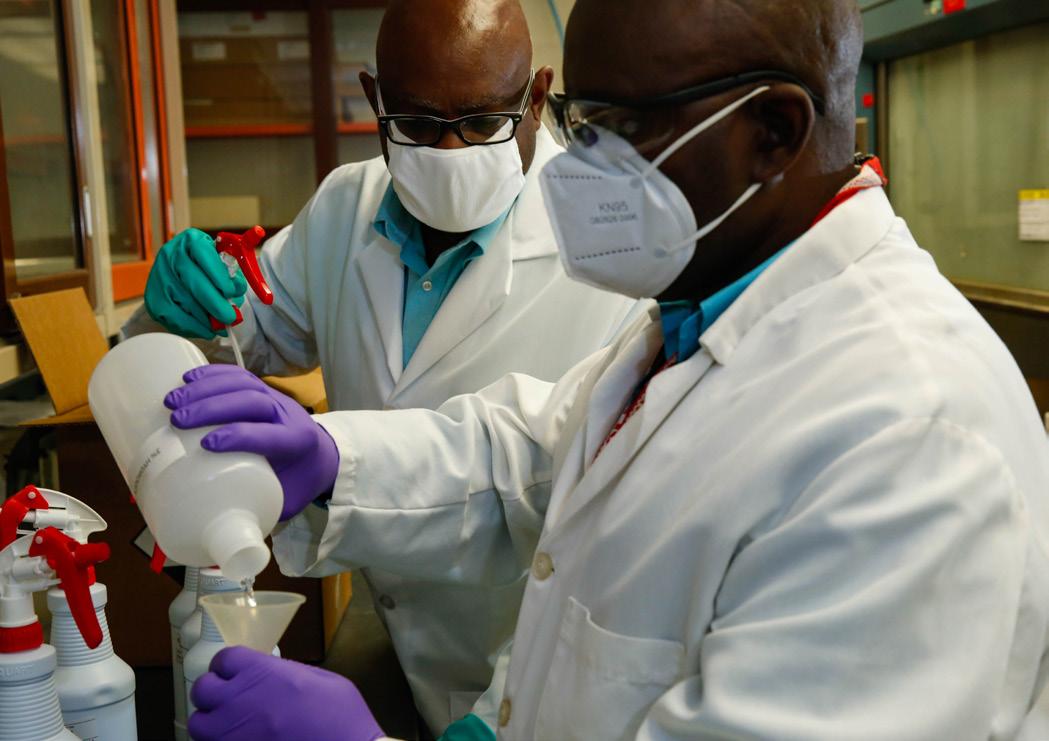
6 minute read
HYDROGEN PEROXIDE SPRAY
3% Hydrogen Peroxide Spray, 100% Teamwork and Care: Norfolk Naval Shipyard’s Newest Solution to Fight COVID-19
STORY BY HANNAH BONDOC • PUBLIC AFFAIRS SPECIALIST PHOTOS BY TONY ANDERSON • NNSY PHOTOGRAPHER
Advertisement
In its ongoing fight against COVID-19, Norfolk Naval Shipyard (NNSY) has found a new way to protect its employees with a little common household chemical solution: three percent hydrogen peroxide. Typically found in bleaching agents and even naturally occurring in the human body, NNSY’s Reactor Engineering Division (Code 2310) and Nuclear Material Division (Code 2305) have used the diluted chemical combination to make a cleaning solvent that has less restrictions than the current disinfectant being used at the shipyard.
According to Code 2310’s Ventilation Support Branch (Code 2310.4) Engineer Cynthia Raines, the hydrogen peroxide initiative began when certain spaces in the shipyard needed better cleaning agents than the ones being used at the time: Strike-1-N and alcohol dampened cloths. “Although the two cleaning solutions being used at the time were effective, the Strike-1-N cleaning solution sometimes caused irritation to the upper respiratory tract upon inhalation,” Raines said, “and alcohol dampened cloths posed a flammability hazard.” With the goal to find something that effectively eliminated COVID-19 surface contamination without posing health and safety risks, Code 2310.4 looked in the Naval Sea Systems Command Fleet Advisory’s Guidance for Surface Ships Coronavirus Disinfectant Products and Procedures—and found their solution. Raines explained, “This guidance indicated that hydrogen peroxide at a minimum of 0.5 percent has the power to disinfect COVID-19 when sprayed on surfaces.” She added that the new disinfectant is more affordable, easier to obtain, and nonhazardous; it also will be powerful enough to kill COVID-19 contaminants on impact, provided that the three percent hydrogen peroxide remains on surfaces to be disinfected for a minimum of ten minutes, without wiping.
As simple as implementing a new cleaning agent might seem, the task did not come without obstacles. “The greatest challenges during this process were determining where three percent hydrogen peroxide was acceptable for use,” Raines said, “and who would perform the work necessary to implement it as a cleaning solution for areas potentially exposed to COVID-19.” Thankfully, her team’s devoted members were able to overcome this and implement it.
While the Mid-Atlantic Regional Materials Test Laboratory (Code 134) is in the process of diluting and bottling hydrogen peroxide for the new disinfectant, the only thing left in the codes’ endeavor to put it into action is the green light. “Once we receive the sign-off, we will issue the change to our procedure and three percent hydrogen peroxide can be implemented for COVID-19 disinfection in work areas,” Raines said. “Additionally, the Nuclear Facility Maintenance Branch (Code 2380.5) is in the development stage for their procedure to implement three percent hydrogen peroxide as the primary disinfectant in their work facilities.”
Raines stated that the three percent hydrogen peroxide spray initiative would not have been possible without the help of multiple departments. “Code 2310.4 led this initiative,” she said, “but between Nuclear Material Analysis Branch (Code 2305) Head Gerry Zaner obtaining hydrogen peroxide and spray bottles from suppliers; Job Readiness Cell (Code 530) lead and COVID-19 Personal Protective Equipment (PPE) Zone Manager Mark Ragsdale maintaining bottles of three percent hydrogen peroxide for general shipyard use; Occupational Safety, Health, Environmental (Code 106) providing safety background knowledge; and Nuclear Engineering and Planning Department’s (Code 2300) Department Director Curt Hart, Division Head Mike Kwiatkowski, and Ventilation Support Rob Harrington who propelled the process forward, this was a true product of team effort!”
In working to put the spray into effect, the opportunity to demonstrate the C.O.R.E. value of Care and protect others from the virus was not lost on the team. “We have this virus going around and it is tough because you may not even know if you have it for a two-week period of time,” Raines said. “That’s why it is important that we have this disinfectant spray because not only is it cheap, safe, and easy to obtain, but also it enables us to effectively prevent the spread of COVID-19.” A product of care and teamwork, the new peroxide spray will help keep the virus away and allow employees to stay safe at NNSY!
LEFT: Mid-Atlantic Regional Materials Test Laboratory’s (Code 134) lab director Lyndon Clark and Senior Chemist Dickson Aweanung prepare hydrogen peroxide spray; From left to right: Mid-Atlantic Regional Materials Test Laboratory’s (Code 134) lab director Lyndon Clark, Ventilation Support Branch’s (Code 2310.4) engineer Cynthia Raines, and Senior Chemist Dickson Aweanung (Code 134).

MEET WILLIAM LEIDEL: NNSY'S NEW COMMAND INFORMATION OFFICER

STORY BY TROY MILLER • PUBLIC AFFAIRS SPECIALIST

In 1987, a native of Long Island, New York started his first venture into Norfolk Naval Shipyard (NNSY).
William “Bill” Leidel was a recent graduate of Virginia Polytechnic Institute and State University where he earned a degree in industrial engineering.
“I was assigned to Industrial Engineering (Code 380) and spent most of my time supporting the inside machine shop,” said Leidel.
During his stint at NNSY, he became the project manager for the Advanced Industrial Management (AIM) System, which had its initial rollout on Windows in 1999. “AIM is a work planning and execution system,” said Leidel. “It is still used today at NNSY.”
After 13 years at the shipyard he left to pursue other opportunities elsewhere. His most recent position was the Activity Command Information Officer for Naval Sea Systems Logistics Center, which has a detachment office at NNSY. Now he’s back at NNSY as its Command Information Officer (Code 109) and is ready to continue the high quality work that Code 109 has been producing. “Code 109 is in a fantastic position of strength because of the leadership that Bobby McClure, Chip Harrison and the division heads have provided,” said Leidel. “My plan is to pick up where they left off and continue to refine processes that will help NNSY to achieve its mission of returning ships back to the fleet on time and at cost.”
Leidel feels that one of the strengths that he brings with him to the new position is communication. “I know not everyone speaks technical jargon when it comes to computers and technology,” said Leidel. “I work on speaking to the customer in their language. I come up with analogies that help make things clearer.”
Leidel will take a fresh look at the IT process structures to see what he and his new team can do to improve them. One way he plans to do that is by opening the aperture to innovation. “Coming up with new ways of doing things and new tools we can add to our collection is critical if we want to see the success and quality that we’ve shown in the past,” said Leidel. “This is where Code 109 can really make a connection, especially on the waterfront.”
In his off time, Leidel is an avid runner. It is one way he keeps in shape and it helps him to clear his mind. He is also a beer enthusiast who enjoys brewing his own beer when he can, and going on beer tastings at local breweries.
Leidel’s favorite movie is Groundhog Day; but he knows this time at NNSY will be different due to the fact he has a different type of job and responsibilities.
“I’m looking forward to being part of America’s Shipyard,” said Leidel. “Now I can use the experience I gained working on the waterfront back in the 90s to serve the entire shipyard, the best I can.”






